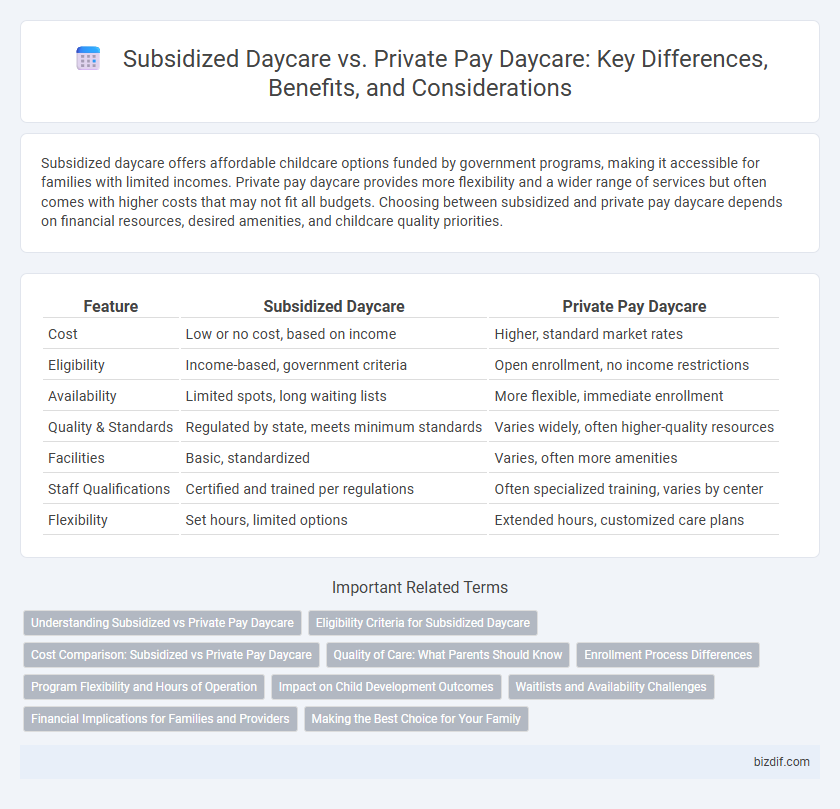Subsidized daycare offers affordable childcare options funded by government programs, making it accessible for families with limited incomes. Private pay daycare provides more flexibility and a wider range of services but often comes with higher costs that may not fit all budgets. Choosing between subsidized and private pay daycare depends on financial resources, desired amenities, and childcare quality priorities.
Table of Comparison
| Feature | Subsidized Daycare | Private Pay Daycare |
|---|---|---|
| Cost | Low or no cost, based on income | Higher, standard market rates |
| Eligibility | Income-based, government criteria | Open enrollment, no income restrictions |
| Availability | Limited spots, long waiting lists | More flexible, immediate enrollment |
| Quality & Standards | Regulated by state, meets minimum standards | Varies widely, often higher-quality resources |
| Facilities | Basic, standardized | Varies, often more amenities |
| Staff Qualifications | Certified and trained per regulations | Often specialized training, varies by center |
| Flexibility | Set hours, limited options | Extended hours, customized care plans |
Understanding Subsidized vs Private Pay Daycare
Subsidized daycare offers reduced childcare costs through government funding, making quality early childhood education affordable for low-income families. Private pay daycare operates without financial assistance, typically providing more flexible schedules, diverse programs, and enhanced facilities at higher prices. Choosing between subsidized and private pay daycare depends on budget, desired childcare quality, and specific family needs regarding location, hours, and curriculum.
Eligibility Criteria for Subsidized Daycare
Subsidized daycare eligibility typically requires families to meet specific income thresholds, often based on federal or state poverty guidelines. Priority is given to low-income households, children with special needs, and families experiencing temporary financial hardships. Documentation such as proof of income, residency, and employment status is usually required to qualify for subsidized childcare programs.
Cost Comparison: Subsidized vs Private Pay Daycare
Subsidized daycare programs significantly reduce the cost burden for families by offering care at a fraction of the price compared to private pay daycare centers, which often charge thousands of dollars per month. Eligibility for subsidized daycare typically depends on income level and family size, enabling low-income households to access affordable, quality childcare services. In contrast, private pay daycare requires full out-of-pocket payment, which can vary widely based on location, facility quality, and additional services, making it a less accessible option for many families.
Quality of Care: What Parents Should Know
Subsidized daycare programs often meet state-mandated quality standards and offer access to trained caregivers, making them a reliable choice for consistent child development support. Private pay daycare centers may provide enhanced amenities and lower child-to-caregiver ratios, which can improve individualized attention and tailored learning experiences. Parents should evaluate accreditation, staff qualifications, and curriculum quality when choosing between subsidized and private pay options to ensure optimal care for their children.
Enrollment Process Differences
Subsidized daycare enrollment typically requires families to meet specific income and eligibility criteria, involving documentation such as proof of income, residency, and sometimes referrals from social services. In contrast, private pay daycare centers often have a straightforward enrollment process focused on availability and contractual agreements without stringent eligibility checks. Waiting lists are more common in subsidized programs due to limited spots, while private centers usually offer immediate enrollment based on capacity and fee payment.
Program Flexibility and Hours of Operation
Subsidized daycare programs often have set hours and limited flexibility to accommodate funding guidelines and eligibility requirements, prioritizing affordability for low-income families. Private pay daycare centers typically offer extended hours, including early mornings, evenings, and weekends, with tailored schedules to meet diverse parental needs. Families seeking flexible childcare solutions may find private pay options more accommodating, while subsidized programs provide essential support within structured operating times.
Impact on Child Development Outcomes
Subsidized daycare programs often provide access to higher-quality early childhood education for low-income families, positively influencing cognitive, language, and social-emotional development. Private pay daycare may offer more specialized curricula and smaller teacher-to-child ratios, enhancing individualized attention and fostering advanced skill development. Research indicates that consistent, high-quality care in either subsidized or private settings contributes significantly to improved school readiness and long-term academic success.
Waitlists and Availability Challenges
Subsidized daycare programs often face long waitlists due to high demand and limited government funding, leading to delayed access for many families. Private pay daycare centers typically offer more immediate availability, although they come at a significantly higher cost. Families must weigh the urgency of securing care against budget constraints when choosing between subsidized and private pay options.
Financial Implications for Families and Providers
Subsidized daycare significantly reduces out-of-pocket expenses for low- to moderate-income families, making early childhood education more accessible and easing financial burdens. Providers participating in subsidy programs often receive lower reimbursement rates compared to private pay fees, which can impact their revenue and operational budgets. Families opting for private pay daycare encounter higher immediate costs but might benefit from more flexible services and higher quality offerings, influencing provider income stability and program sustainability.
Making the Best Choice for Your Family
Choosing between subsidized daycare and private pay daycare depends on factors like family income, quality of care, and your child's specific needs. Subsidized daycare offers affordability and access to licensed providers, while private pay daycare often provides more flexible hours and specialized programs. Evaluating your budget alongside your priorities for educational enrichment and caregiver-to-child ratios helps ensure the best decision for your family's well-being.
Subsidized Daycare vs Private Pay Daycare Infographic

 bizdif.com
bizdif.com